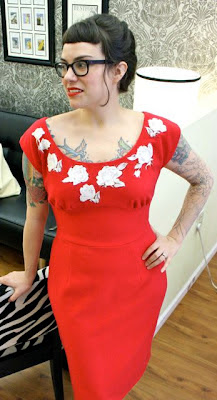Anyway, underneath all that "gone to seed" mess, we found this:
Tiny little asparagus (asparagi?) already popping up. I was pretty excited to see new, beautiful, edible plants underneath all that dead stuff.
Cricket used to hide in the asparagus bramble, and tried to cozy up in the waste pile after cleared it all out of the garden. Sorry Cricket. You'll have to wait til it goes to seed again.
Here's the asparagus a few days later and after I pulled all the weeds in this patch. The asparagus has been growing pretty quickly since our weather has continued to be beautiful. They're purple, but they turn green as you cook them. And yes, they are delicious.
The next task was to recover the strawberries hiding among the weeds in center of the garden. Turns out, there were loads of strawberries - more than we could possibly use. Judy told me strawberries have to have plenty of room or they won't produce many berries, so we went about transplanting them into neat rows, pulling all the weeds in between, and putting all the extra strawberry plants (and there were a lot) into a bucket to be planted elsewhere - in Judy's garden or some other lucky person's.
| starting to establish the rows - neatly designated with stakes and string |
Judy's fast in the garden, but I was quite slow. I don't know how many hours went into this strawberry patch, but I worked for several hours on Saturday and Josh and I went at it again on Sunday for at least five more hours. It went kinda like this - insert a stake, line up the string, find the nearest strawberry plants, pull all the weeds around them, dig all the strawberry plants up, dig new holes for them (at least 10" apart), plant em, move on to the next row. Tired yet? My mom always wonders that I ended up in archaeology since I used to complain when I had to work in the dirt with her (pulling weeds, diggin for sapphires). But there is something really satisfying about seeing this garden take shape, even if it's a lot of work.
Like my get-up? Overalls are the best gardening gear. And a wide brim hat, of course.
| Not sure what I'm doing with my hands here. |
| Josh unloading the mulch |
Adding to my gardening vocab, I now know the meaning and purpose of mulch! It's basically anything that you heap around a plant in order to: 1) keep it warm, 2) cover up weeds and make them die from lack of sunlight, and 3) give it nutrients? Maybe? Depending on the mulch I guess. We bought a truck bed full of the fancy stuff, but Judy said you can use all kinds of different materials, including wood chips or even the weeds you pull up. Following Judy's advice, we laid down long strips of paper between our rows of strawberries and covered these over with mulch. The paper helps smother the weeds (you can also use cardboard), and it also helps your mulch go further.
And here is our cleaned up strawberry patch!
Not bad, eh? Just compare that to the first garden photo and you oughta be impressed. Actually, you may notice there is one more row at the end that we didn't finish. We were exhausted. But tonight I weeded it, and tomorrow I will go back to transplant those strawberries and mulch around them so that it is as beautiful as the others.
I'm really excited to see how the garden does, and I hope I'll have the energy and dedication to keep tending it throughout the season. We still have to decide what else to plant, which is the really fun part. I'm going to do a few flowers - gladiolas! They're so pretty, and they remind me of New Mexico. We're also thinking about heirloom tomatoes, sweet peppers, jalapenos, beans... so many options! I'll keep you posted!






